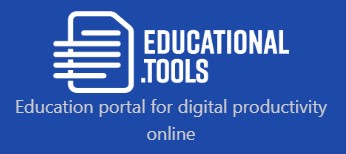
In today’s fast-paced and technology-driven world, educational tools have become essential in enhancing the learning experience for students and educators alike. These tools, ranging from digital platforms to interactive resources, facilitate a more engaging, personalized, and effective approach to education. This article explores various educational tools, their benefits, and their role in shaping the future of learning.
1. Learning Management Systems (LMS)
Learning Management Systems, such as Moodle, Canvas, and Google Classroom, are pivotal in organizing and delivering educational content. These platforms allow educators to create, manage, and distribute course materials, assignments, and assessments in a centralized location.
Benefits:
Streamlined Communication: LMS platforms provide a space for announcements, discussions, and feedback, fostering better communication between teachers and students.
Accessibility: Students can access course materials anytime and anywhere, promoting self-paced learning.
Tracking Progress: Educators can monitor student engagement and performance through analytics, enabling timely interventions when necessary.
2. Interactive Whiteboards
Interactive whiteboards, like SMART Boards, have transformed traditional classrooms into dynamic learning environments. These digital boards allow teachers to display multimedia content, engage students in interactive lessons, and facilitate collaborative activities.
Benefits:
Enhanced Engagement: The interactive nature of these boards captures students' attention and encourages active participation.
Collaboration: Students can work together on the board, fostering teamwork and communication skills.
Multimedia Integration: Teachers can easily incorporate videos, images, and other digital resources into their lessons, catering to various learning styles.
3. Educational Apps
The rise of smartphones and tablets has led to the proliferation of educational apps that provide interactive and gamified learning experiences. Apps like Kahoot!, Quizlet, and Duolingo offer innovative ways to engage students in various subjects.
Benefits:
Accessibility: Students can access learning materials anytime and anywhere, promoting self-directed learning.
Engagement: Gamified elements in these apps make learning fun and motivate students to participate actively.
Diverse Learning Opportunities: A wide range of apps caters to different subjects and skills, allowing for personalized learning experiences.
4. Video Conferencing Tools
Video conferencing tools, such as Zoom, Microsoft Teams, and Google Meet, have become essential for remote learning and virtual classrooms. These platforms enable real-time interaction between teachers and students, regardless of their physical location.
Benefits:
Flexibility: Students can attend classes from anywhere, making education more accessible.
Real-Time Interaction: Video conferencing allows for immediate feedback and discussion, enhancing the learning experience.
Record Keeping: Many platforms offer recording features, allowing students to revisit lessons at their convenience.
5. Collaborative Tools
Collaboration is a key component of modern education, and tools like Google Workspace (formerly G Suite), Microsoft 365, and Trello facilitate teamwork among students and educators.
Benefits:
Real-Time Collaboration: Students can work together on projects in real-time, regardless of their location.
Organization: Tools like Trello help students manage tasks and deadlines, promoting accountability and time management skills.
Feedback: Collaborative tools allow for easy sharing of work, enabling peer feedback and constructive criticism.
6. Assessment Tools
Assessment tools, such as Socrative, Formative, and Edmodo, provide educators with innovative ways to evaluate student understanding and progress.
Benefits:
Immediate Feedback: These tools often provide instant feedback to students, helping them identify areas for improvement.
Variety of Assessment Types: Educators can create quizzes, polls, and surveys to assess student learning in diverse ways.
Data-Driven Insights: Assessment tools offer analytics that help teachers understand student performance trends and adjust instruction accordingly.
Conclusion
The integration of educational tools into the learning process has transformed the way educators teach and students learn. From Learning Management Systems to interactive whiteboards and collaborative tools, these resources enhance engagement, accessibility, and effectiveness in education. As technology continues to advance, the potential for these tools to further enrich the learning experience is immense. By embracing these innovations, educators can create dynamic and inclusive learning environments that prepare students for success in an increasingly digital world. The future of education is bright, and the right tools can make all the difference in achieving educational goals.
